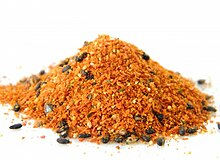Shichi-mi tōgarashi(ThấtVịĐường tân tử,seven-flavor chili pepper),also known asnana-iro tōgarashi(ThấtSắcĐường tân tử,seven-color chili pepper)[1][2]or simplyshichimi,is a commonJapanesespice mixturecontaining seven ingredients.[3]Tōgarashi is the Japanese name forCapsicum annuumpeppers, and it is this ingredient that makes shichimi spicy.[4]
 Shichimi tōgarashi | |
| Alternative names | Nana-iro tōgarashi |
|---|---|
| Type | Spice mixture |
| Place of origin | Japan |
| Invented | 17th century |

Etymology
edit"Shichi" means seven, "mi" means flavor, and "togarashi" is the red chili pepperCapsicum annuum.[5]The blend is also called nanami togarashi.[5]
In the United States, shichimi is sometimes referred to as "Nanami." Both names translate to "seven flavors," but "Nanami" is often used in branding for ease of pronunciation among English speakers. While "shichi" ( thất ) and "nana" ( thất ) both mean "seven" in Japanese, "nana" has a more familiar sound in English, leading to the alternative name.
Ingredients
editA typical blend may contain:
- coarsely ground redchili pepper(the main ingredient)
- groundsanshō( "Japanese pepper" )
- roastedorangepeel (chenpi)
- blacksesame seed
- white sesame seed
- hempseed[6]
- groundginger[3]
- norioraonori(seaweed)
- poppy seed[5]
- yuzupeel[5]
Some recipes may substitute or supplement these withrapeseedorshiso.Shichimi is distinguished fromichi-mi tōgarashi(NhấtVịĐường tân tử,ichimi, one-flavor chili pepper),which is simply ground red chili pepper.[7]
Use
editThe blend is traditionally used as a finishing spice. It is ubiquitous in restaurants in Japan; a shaker is sometimes on every table along with salt and pepper shakers and bottles of soy sauce.[5]It is often consumed with soups and on noodles andgyūdon.Some rice products, such asrice cakes,agemochiand roastedrice crackers,also use it for seasoning.[8]
History
editShichimi dates back at least to the 17th century, when it was produced by herb dealers inEdo,[3]current day Tokyo, and sometimes it is referred to asYagenbori(DượcNghiênQuật,from the name of the original place of production).Most shichimi sold today come from one of three kinds, sold near temples: Yagenbori(やげん quật)sold nearSensō-ji,Shichimiya(Thất vị gia)sold nearKiyomizu-dera,and Yawataya Isogorō(Bát phiên ốc cơ ngũ lang)sold nearZenkō-ji.[citation needed]
Culture
editIn modern times, the product is generally sold as a formulated product, but in the past it was prepared and sold according to the customer's needs ( thất vị đường tân tử mại り). Even today, performances can be seen at festival stalls.
See also
editReferences
edit- ^Nihon Kokugo Daijiten(dictionary).
- ^Shin Meikai kokugo jiten(dictionary).
- ^abcZeldes, Leah A.(2010-04-14)."Eat this! Shichimi togarashi, zesty Japanese seasoning".Dining Chicago.Chicago's Restaurant & Entertainment Guide. Archived fromthe originalon 2010-10-07.Retrieved2010-05-22.
- ^Gordenker, Alice, "Shichimi Togarashi: The Japanese 7-Spice Mix You Have to Try",Japanese Food Guide
- ^abcdeKim, Eric (2023-10-04)."This Store-Bought Spice Blend Makes Everything Taste Better".The New York Times.ISSN0362-4331.Retrieved2023-10-07.
- ^Hongo, Jun (Dec 11, 2007)."Hemp OK as rope, not as dope".The Japan Times.Archived fromthe originalon 12 November 2016.Retrieved2010-05-22.
- ^Kaneko, Amy (2007).Let's Cook Japanese Food!.Chronicle Books. p. 20.ISBN978-0-8118-4832-9.
- ^Kilcoyne, Kevin (3 February 2020)."Shichimi: The Seven Spice Blend of Japan".Kokoro Care Packages.Retrieved14 April2024.
and can even be found as a flavor for rice crackers and agemochi